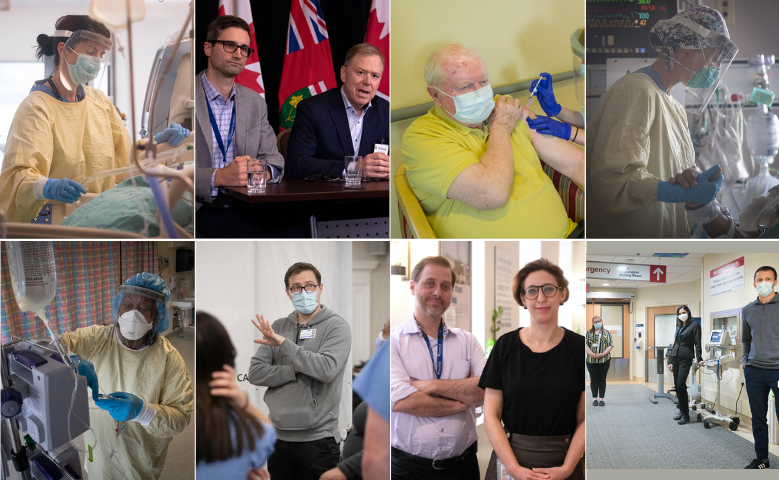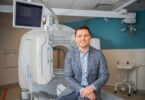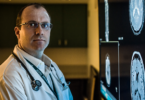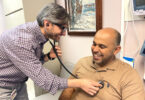On March 11, 2020, the World Health Organization officially declared COVID-19 a global pandemic. It was a moment that changed life for everyone around the globe. Here at Sunnybrook Health Sciences Centre, Canada’s first presumptive case of COVID-19 had been confirmed in a patient on January 25, 2020.
In true Sunnybrook spirit, teams from every corner of the hospital and across all sites came together. A community of donors mobilized to support our work at a critical time. There was a rapid implementation of virtual patient care, the establishment of COVID-19 safety teams and a dedicated research focus on this emerging health threat. From being part of the Canadian research team that isolated SARS-CoV-2, the virus responsible for the COVID-19 pandemic, Sunnybrook has since led and participated in hundreds of COVID clinical trials.
No matter their role or position, every Sunnybrook staff member and volunteer was affected in some way, and every profession and team stepped up to do their part.
As we mark this five-year milestone, some of the voices featured in an original photo essay have offered their reflections. This small snapshot of experiences is part of the greater effort seen across Sunnybrook and our incredible staff, physicians, volunteers and donors. While it’s difficult to include all voices and experiences, acknowledging everyone’s leading and compassionate work is easy.
Thank you, Team Sunnybrook!
The novel coronavirus arrives at Sunnybrook
On an unassuming day in January, Sunnybrook’s Emergency Department would receive the first patient in Canada to have a confirmed case of COVID-19. It would mark a turning point for Sunnybrook and the country.
Dr. Jerome Leis, Medical Director, Infection Prevention & Control: I vividly remember receiving the call. Based on their exposure risk and symptoms, we had a very strong suspicion from the get-go that this is what this patient had. We have routine protocols we’ve developed over the last 20 years since SARS, that there was nothing extraordinary that needed to be done. And yet this particular case solicited so many reactions, given the significance of what it represented for Canada and for the trajectory of the epidemic evolving toward a pandemic.
Dr. Justin Hall, Chief of Sunnybrook’s Emergency Department: What really stood out in the beginning was the response of my colleagues who treated the first COVID patient in Canada when they arrived in the Emergency Department.
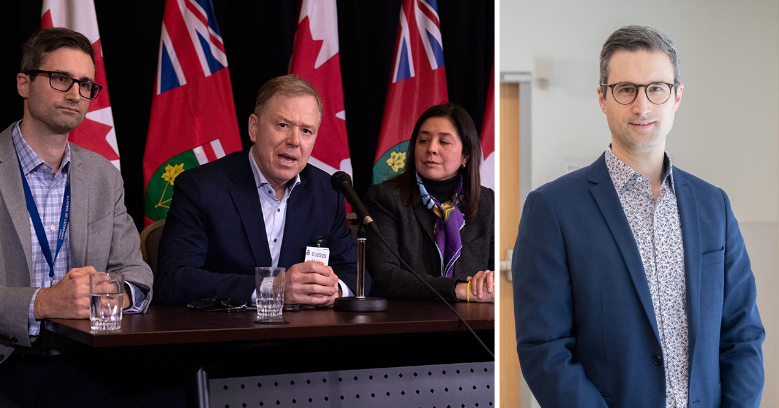
Left: Dr. Jerome Leis, Sunnybrook’s Medical Director of Infection Prevention and Control, and Dr. Andy Smith, Sunnybrook President & CEO, spoke at a press conference alongside local and provincial health officials when the first presumptive case of the novel coronavirus was confirmed. Right: Dr. Leis today.
Dr. Jerome Leis: In retrospect, it was a historical event that we were participating in, and we were just doing our jobs. It was, ‘okay, this patient needs our care,’ just like anyone else that comes through Sunnybrook.
Dr. Samira Mubareka, microbiologist & infectious diseases physician: It felt like a major moment in time because it represented the first coronavirus pandemic, even though two other coronaviruses, SARS and MERS, were of high consequence and caused international outbreaks. At the time, though, we didn’t know whether the mortality would be as high, in the range of 10 to 30 per cent mortality. We were starting to get a sense, but there were so many unknowns in early 2020.
Andrew Kennedy, patient care manager & head of assessment centre and vaccine clinic (then); Director, Clinical Informatics (now): Right before COVID was considered a global pandemic, I was a patient care manager at the Holland Centre, and my boss at the time called me to ask if I was interested in setting up our assessment centre. At this stage, I wasn’t expecting much of the pandemic; none of us were. Then all of a sudden it morphed into something else and the world shut down. More and more people started getting sick. We had to set up the assessment centre as a matter of urgency, which we did in a matter of days.
Julie Nardi, respiratory therapist (then); performance improvement coordinator (now): In the first few weeks of the pandemic, the urgency to keep up with the rapidly changing infection control guidance was overwhelming. As a clinical practice leader, I was especially focused on making sure the team had the most up-to-date information at all times, because everyone’s safety depended on it. We were constantly adjusting to new protocols. It required a lot of communication and quick decision-making, as we all had to stay informed and adapt quickly.
Karen Montgomery, physiotherapist (then); acute stroke coordinator (now): Initially, the fear and uncertainty were overwhelming, especially as we faced the unknown while caring for critically ill COVID patients.
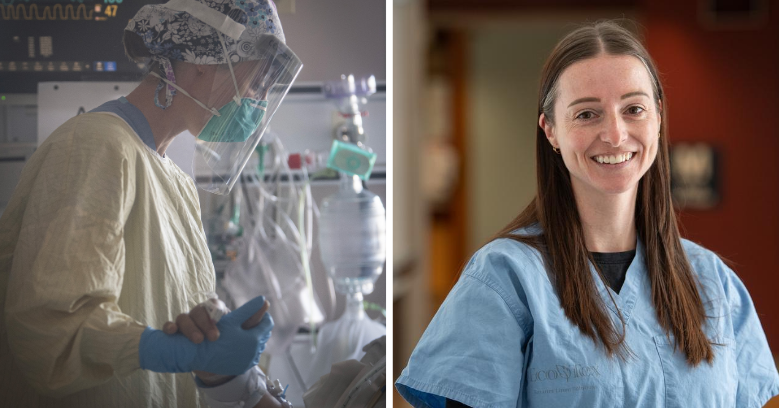
Left: Karen Montgomery with a COVID-19 patient in a critical care unit then. Right: Karen today.
Dr. Justin Hall: There was great uncertainty and some fear. The need for personal protective equipment for all patients changed how we saw them, and patients were also dealing with isolation with visitor restrictions in place.
Richard Ratcliffe, resident at Sunnybrook’s Veterans Centre: The Veterans Council has about 40 people in the group, but we didn’t have to shut down because of the pandemic. We were probably one of the first committees at Sunnybrook that went on Zoom.
Steffanye Michaelson, Director of Operations, Odette Cancer Centre: The teams always pull together, but in the first weeks and months of the pandemic, this was on a whole different level. We were tired, but the level of commitment was brought to a new height to get our patients, families and each other through it. I wanted to be by my team’s side and work together to keep each other safe, as well as the public.
Isolating the virus
The same week that the pandemic was declared, Sunnybrook scientists announced that they had isolated SARS-CoV-2. The isolated virus would go on to help researchers in Canada and around the world develop better diagnostic testing, treatments and vaccines, and gain a better understanding of SARS-CoV-2 biology, evolution and clinical shedding.
Dr. Samira Mubareka: We were very fortunate. Because we had already been approved to work in Level 3 containment facility at the University of Toronto, we were able to get permission to work on this novel coronavirus very quickly. We essentially had three things: the infrastructure, the regulatory support and approval to do it, and most importantly, the personnel. Dr. Arinjay Banerjee, who was doing his post-doctoral research at McMaster University with Dr. Karen Mossman, came to work with us. He was one of the few people in the country who had ever worked with a high-consequence coronavirus.
Dr. Rob Kozak, scientist and clinical microbiologist: We were really lucky to have Arinjay, because he was already doing research on coronaviruses like MERS. He was the one who did a lot of the hands-on research.
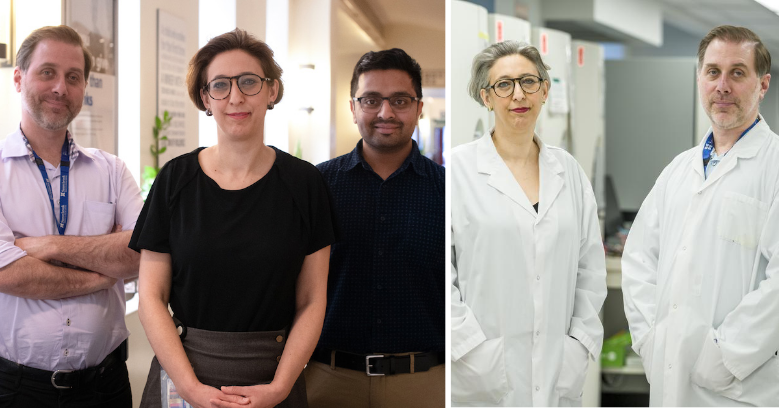
Pictured left to right: Dr. Robert Kozak, Dr. Samira Mubareka, Dr. Arinjay Banerjee after isolating the SARS-CoV-2 virus. Right: Dr. Mubareka and Kozak, who still work at Sunnybrook, today.
Dr. Samira Mubareka: He moved in with my family and I during that time. He’s become like a little brother. We still collaborate very closely.
Dr. Rob Kozak: Being such a meticulous scientist, he didn’t jump the gun. He was like, can we do PCR testing to confirm that it’s SARS-CoV-2? Can we do some sequencing? Let’s really cross our T’s, dot our I’s, and be 100 per cent certain.
Dr. Samira Mubareka: It felt very momentous. It was the realization of, ‘Whoa, we got it.’ Personally, it was somewhat conflicting: on the one hand, there’s this terrible virus, but at the same time, we were thrilled because now we could move the science ahead.
Dr. Rob Kozak: We isolated the virus right as things were shutting down. It was nice to have this little piece of good news to say, hey, even though things are getting worse, we have something and people can start using it for research. It was a bright spot.
Dr. Samira Mubareka: Once we had isolated the virus, it became a really key tool for scientists across Canada. I can’t even remember how many material transfer agreements we did just to share the virus. As time went on, more and more labs became approved, more and more people got trained and then we continued to isolate the different variants of concern.
The pandemic is declared
When the pandemic was declared on March 11, everyone had to pivot quickly to respond to new demands, new ways of working, and new patient care restrictions. Although there was a profound sense of uncertainty, there was no lack in people coming together to help.
Karen Montgomery: The pandemic profoundly changed my work in the ICU, both in terms of the challenges we faced and the way we adapted. We had to quickly adjust to new protocols, staffing challenges, and a surging patient load. We also had to learn to manage the emotional strain of not being able to have family members present for support, which was especially hard for both the patients and their loved ones.
Andrew Kennedy: I have this vivid memory of when we first opened the assessment centre, which initially prioritized staff and physicians. There was this long line of Sunnybrookers waiting in the pouring rain the day we opened. This was anxiety-inducing because I was unsure we would be able to handle the sheer number of people that wanted to get tested and back to work. Seeing all those people galvanised me to act. We hired more staff for the assessment centre immediately because we needed all the support we could get.
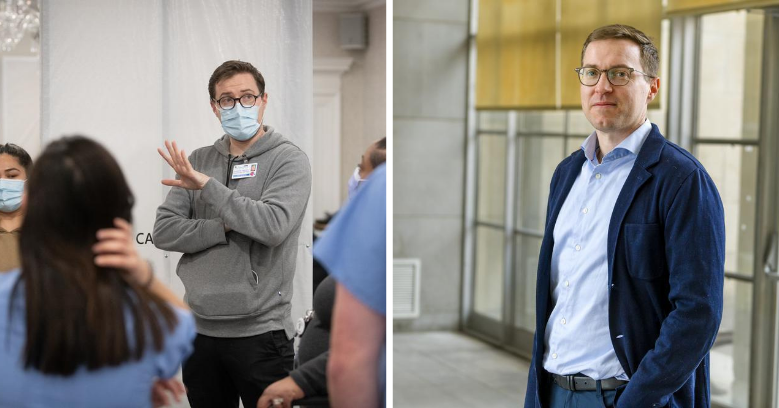
Left: Andrew Kennedy speaking to staff at Sunnybrook’s COVID-19 assessment centre. Right: Andrew today.
Dr. Samira Mubareka: Sunnybrook was a highly supportive environment. There was a lot going on the research and the science side, but at the same time, there were people we worked with very closely with – colleagues from infectious diseases and infection control who swung right into action. They were assessing everybody who tested positive, and managing things like virtual care, whether or not or not patients need to come into hospital, arranging for home oxygen monitors to be delivered, and more. There were some amazing infectious diseases docs and nurse practitioners who supported and sustained a lot of that.
Julie Nardi: When I think about working at Sunnybrook during the pandemic, I immediately think about the incredible sense of teamwork that defined those months. As respiratory therapists, we are rarely ever working in isolation, but during the pandemic, that collaborative spirit became even more pronounced. We all leaned on each other, and that mutual support helped us get through the toughest moments together.
Richard Ratcliffe: The Legions graciously set us up with Smart TVs in all the Veterans Centre lounges, so we were able to host Council meetings with smaller groups attending in different locations. We’re still using this approach today.
Dr. Justin Hall: There was very strong teamwork and camaraderie. Everyone came together under great uncertainty within and across programs.
Dr. Rob Kozak: It was nice to see how quickly people would jump at opportunities to help, like if we were looking for people to work or volunteer in the lab. When the call was put out, people answered.
From the darkest days…
Julie Nardi: One of the most difficult aspects of the pandemic was the mandated safety restrictions that were in place which impacted family members wanting to visit their loved ones. For patients, especially those who were critically ill, separation from their families was heartbreaking but necessary. As health-care providers, we often found ourselves acting as the primary source of support.
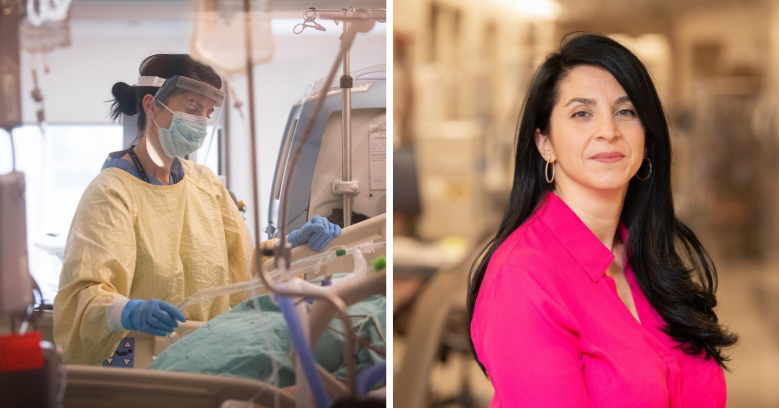
Left: Julie Nardi, a respiratory therapist with a COVID-19 patient in a dedicated COVID-19 unit then. Right: Julie today.
Karen Montgomery: The hardest part was undoubtedly the visitor restrictions. Not being able to have family by a patient’s side, especially as they neared the end of their life, was heartbreaking and emotionally draining for everyone involved.
Richard Ratcliffe: In the initial stages we couldn’t do much, really, so there was some loneliness. There were a lot of restrictions in place. But I had an iPad and access to the internet, so I was able to stay busy.
Brenda Mayers, registered nurse: During the pandemic, safety comes to mind; making sure my PPE was applied properly and creating no risk of exposure to the virus. High anxiety also comes to mind. Even though we had the tools to protect ourselves, some staff became ill.
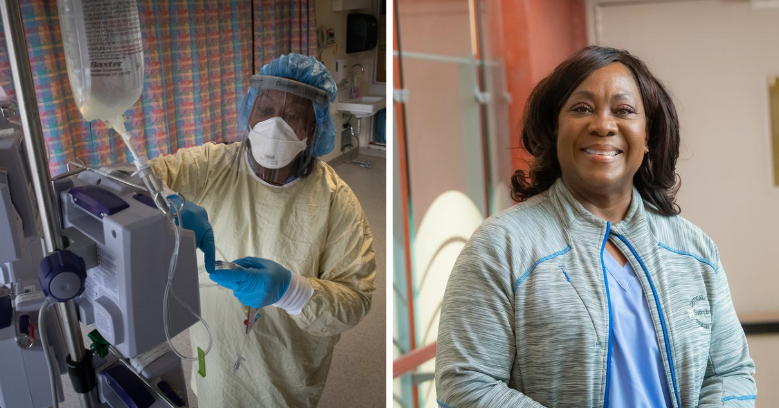
Left: Brenda Mayers, a registered nurse in a Sunnybrook critical care unit, then. Right: Brenda today.
Dr. Jerome Leis: There was a significant challenge with misinformation, and it’s actually only gotten worse over time. I think that is one of my greatest concerns with our ability to navigate the next major public health threat.
…to glimmers of hope…
Julie Nardi: I was working with a tracheostomy patient to restore their voice. After weeks of effort, they were able to speak clearly enough to participate in a video call with their loved ones. Seeing the joy and relief on the patient’s face, and hearing the emotion in their family’s voices was incredibly rewarding. It was a reminder of how crucial human connection is, and how, even in the toughest circumstances, we found ways to bring people together.
Richard Ratcliffe: I’m a retired lay minister in the Anglican Church. When we could only meet in small groups, and didn’t have many external clergy coming into the Veterans Centre, I stepped in to conduct some morning prayers. Together with the Spiritual Care staff at the hospital, we stepped up and figured it out.
Karen Montgomery: We had a long-term, ventilated patient who was deeply depressed because his wife could not visit. In an effort to re-engage him, I reached out to his wife for help. She would come wearing a bright red sweater and stand on the grass outside M-Wing, where we could see her from the patient’s window. Requiring a lot of coordination, and with the support of the interdisciplinary team, we would mobilize the patient to a chair, wheel him over to the window to see her, and put her on speakerphone so he could hear her voice as well. Often, there was no portable ventilator available, so we would take turns manually ventilating the patient to ensure he did not miss his ‘date’ with his wife. This act was not only incredibly motivating for the patient and reassuring for the wife, but it was equally impactful for the staff involved. It was a truly special moment of connection during such an isolating time.
Dr. Justin Hall: A special moment was emerging from the pandemic and having our first departmental social in person after years of only virtual events.
Brenda Mayers: Over the course of five years, safety continues to be consistent with our staff and organization. Anxiety has diminished.
Dr. Justin Hall: It was a time of significant innovation to support new ways of assessing and supporting patients. One example is the creation of the Virtual Emergency Department to ensure access for patients in a way that was comfortable for them. Since that time, this model has been expanded into a regional program through Ontario Health.
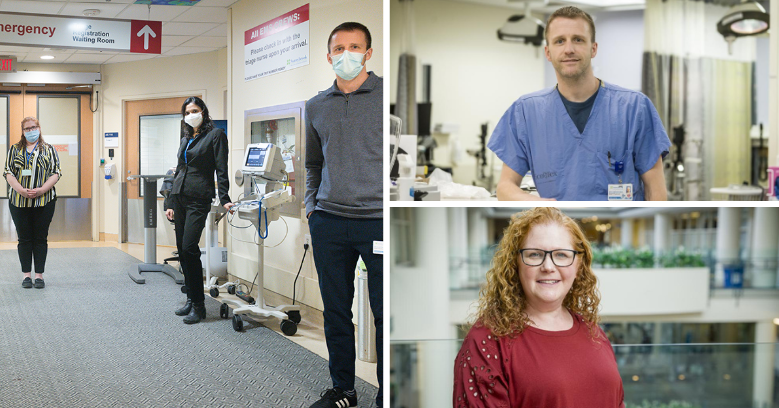
From left to right: Steffanye Michaelson, Dr. Aikta Verma, the former chief of emergency medicine at Sunnybrook, and Dr. Justin Hall then. Right: Steffanye and Dr. Hall today.
Karen Montgomery: I also cannot forget the ‘hairstyles’ we were forced to make do with while salons were closed. I still chuckle when I think back to staff members cutting each other’s hair. I don’t think I will ever forget getting my first Sunnybrook haircut.
…Team Sunnybrook pulled together and pulled through.
Karen Montgomery: The pandemic brought out a level of teamwork and solidarity that I had never witnessed before. While the circumstances were incredibly tough, it underscored the resilience of health-care workers and the crucial role that collaboration plays in delivering patient care. It also served as a powerful reminder of just how vital empathy and clear communication are – especially during the most trying times. Even five years later, these qualities continue to guide my work and shape how I approach patient care.
Dr. Rob Kozak: We used to joke that a busy day pre-pandemic would be when you test 100 samples for influenza. During the pandemic we were doing 100 samples of COVID before coffee. At our peak, I think we did 11,000 samples in a day.
Steffanye Michaelson: Resilience, family, a sense of ‘we are in it together,’ uncertainty but also a sense of togetherness and facing it together. How each and every role in the organization got us through it. Collaboration really was the backbone of the pandemic. I was and still am in complete awe of everyone’s strength, resilience and ability to pivot on a moment’s notice.
Andrew Kennedy: We were told we needed to set up a vaccine clinic, and then seven days later we had a vaccine clinic. That was truly incredible and wouldn’t have been possible without a group of exceptional people. I remember for the first few months of the vaccine roll out, I was working 15-hour days, seven days a week. But I wasn’t alone in this.
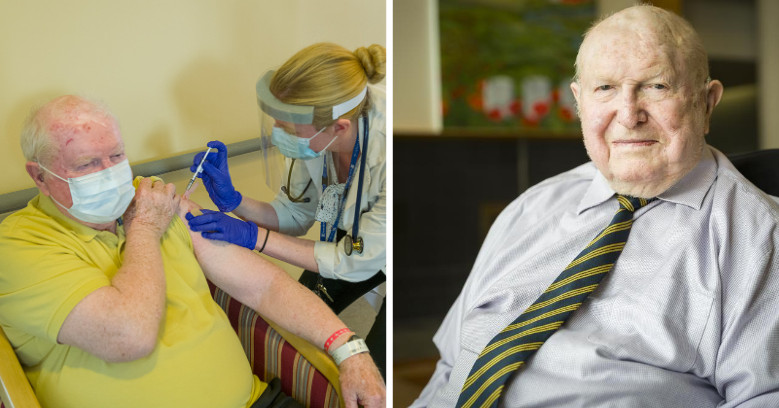
Left: Richard Ratcliffe was one of the first residents of Sunnybrook’s Veterans Centre to receive the COVID-19 vaccine. Right: Richard today.
Dr. Jerome Leis: There are silver linings around the successful, transformative changes that occurred as a result of the pandemic. We have worked towards several improvements that will help better integrate the whole region that Sunnybrook serves in a way that we didn’t do before the pandemic. We’re supporting infection prevention in the long-term care sector. We’re providing access to hospital services either virtually or in-person in a way that helps to bypass the emergency department. The integration between Sunnybrook and its partners is something that was greatly accelerated by the pandemic.
Five years later, while the COVID-19 pandemic has lessened in urgency, the work is not done. Research into emerging pathogens, infectious disease mitigation, and improvements to patient care born from lessons from the pandemic are all ongoing – and the work of Sunnybrook staff, researchers, physicians and volunteers continues.
Dr. Jerome Leis: It’s easy to try to forget a pandemic like COVID-19 and move on, but it’s so important to remember the challenges we faced and what we need to improve for next time; how do we better integrate different parts of the health-care system to respond in a coordinated way, and protect our most vulnerable populations like those who reside in long-term care. Those are all such important lessons that we need to be just as committed to addressing for years to come, just as we were in those early stages of the pandemic.
Dr. Justin Hall: The emergency department environment has become a harder yet more rewarding place to work. We are refocusing our efforts to support organizational change to decrease wait times and lengths of stay and support a better patient and provider work experience.
Julie Nardi: Since the pandemic, I’ve seen a shift toward greater integration of data to drive better care and improve patient outcomes. I can appreciate a broader impact and I’ve gained new skills in quality improvement and patient safety that continue to shape my work.
Dr. Rob Kozak: When Mpox came about, I was lucky to have people on my research team who, by virtue of COVID, were trained to work in Level 3 containment labs. We also have our eye on other emerging viruses. H5N1 is on our radar, so we’re asking questions like how do we develop a test for it, or how does this virus replicate in one set of cells versus another, those sorts of things.
Steffanye Michaelson: I am deeply humbled and fortunate to have been able to go through the pandemic with Team Sunnybrook.
Karen Montgomery: There was this unspoken bond between everyone, whether it was doctors, nurses, respiratory therapists, or support staff – we were all in it together, and that made a huge difference.
Andrew Kennedy: Although those months seem like a blur, one thing really sticks out to me – how Sunnybrookers came together for the common good. I had so much support during that time and it still amazes me what we were able to accomplish.
This article was written by Brianne Tulk, Hania Mattoo and Monica Matys, Communications Advisors at Sunnybrook Health Sciences Centre.


